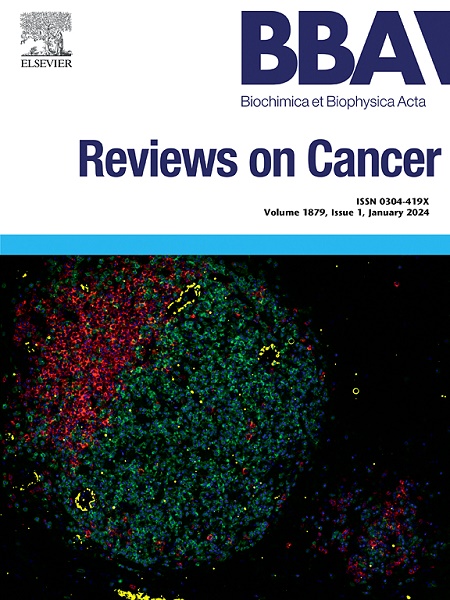Animal models in preclinical evaluation of CAR-T cell therapy: Advantages and limitations
IF 9.7
1区 医学
Q1 BIOCHEMISTRY & MOLECULAR BIOLOGY
Biochimica et biophysica acta. Reviews on cancer
Pub Date : 2025-09-18
DOI:10.1016/j.bbcan.2025.189455
引用次数: 0
Abstract
Chimeric Antigen Receptor T (CAR-T) cell therapy is a promising new treatment category. Animal models have played a pivotal role in advancing CAR-T cell therapy. However, no animal model fully replicates human physiology, leading to unsuccessful translation from preclinical models to clinical trials. Understanding the advantages and limitations of various animal model choices requires insight into CAR-T cell mechanisms and their interactions across experimental contexts.
CAR-T cell immunobiology differs between animal models and humans. This disparity is reflected in the limited translational capacity of pharmacological parameters and the absence of key immunological interactions in animal models compared to those seen in human trials. Additionally, the antigen specificity of the CAR introduces translational limitations. Differences in antigen density and expression among different cellular populations across species are critical factors to consider when interpreting preclinical results. Xenoreactivity, stemming from the original T-cell receptor repertoire, also limits experimental duration and timing in mouse models.
Modeling human cancer in animal models requires many considerations. Cancer heterogeneity varies significantly between patient-derived xenografts and cell-line-based xenografts. Syngeneic models more accurately mimic interactions between CAR-T cells and other immune components, while xenograft models better reflect human tumor antigen expression. Beyond CAR-T-specific challenges, issues with standardization and replication in animal studies affect the reliability of the results. Furthermore, ethical guidelines should guide experimental planning to minimize animal use and prioritize humane treatment.
This review explores the strengths and limitations of animal models preclinical CAR-T cell therapy research, while offering critical considerations for interpreting results and designing experiments.
CAR-T细胞治疗临床前评估的动物模型:优点和局限性。
嵌合抗原受体T (CAR-T)细胞疗法是一种很有前途的新型治疗方法。动物模型在推进CAR-T细胞治疗中发挥了关键作用。然而,没有动物模型完全复制人体生理,导致不成功的从临床前模型转化为临床试验。了解各种动物模型选择的优点和局限性需要深入了解CAR-T细胞机制及其在实验背景下的相互作用。CAR-T细胞免疫生物学在动物模型和人类之间是不同的。与人体试验相比,这种差异反映在动物模型中药理学参数的有限翻译能力和缺乏关键的免疫相互作用。此外,CAR的抗原特异性引入了翻译限制。在解释临床前结果时,不同物种间不同细胞群的抗原密度和表达差异是需要考虑的关键因素。源于原始t细胞受体库的异反应性也限制了小鼠模型的实验时间和时间。在动物模型中模拟人类癌症需要考虑许多因素。肿瘤异质性在患者来源的异种移植物和基于细胞系的异种移植物之间有显著差异。同基因模型更准确地模拟CAR-T细胞与其他免疫成分之间的相互作用,而异种移植模型更好地反映人类肿瘤抗原的表达。除了car - t特异性的挑战之外,动物研究中的标准化和复制问题也影响了结果的可靠性。此外,伦理准则应指导实验计划,以尽量减少动物使用和优先考虑人道待遇。这篇综述探讨了动物模型临床前CAR-T细胞治疗研究的优势和局限性,同时为解释结果和设计实验提供了关键的考虑因素。
本文章由计算机程序翻译,如有差异,请以英文原文为准。
求助全文
约1分钟内获得全文
求助全文
来源期刊

Biochimica et biophysica acta. Reviews on cancer
医学-生化与分子生物学
CiteScore
17.20
自引率
0.00%
发文量
138
审稿时长
33 days
期刊介绍:
Biochimica et Biophysica Acta (BBA) - Reviews on Cancer encompasses the entirety of cancer biology and biochemistry, emphasizing oncogenes and tumor suppressor genes, growth-related cell cycle control signaling, carcinogenesis mechanisms, cell transformation, immunologic control mechanisms, genetics of human (mammalian) cancer, control of cell proliferation, genetic and molecular control of organismic development, rational anti-tumor drug design. It publishes mini-reviews and full reviews.
 求助内容:
求助内容: 应助结果提醒方式:
应助结果提醒方式:


